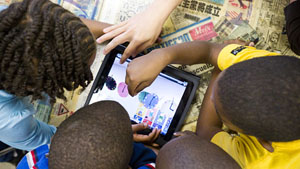iPad more than a gadget
Education professor Kristin Redington Bennett knows iPads can revolutionize the K-12 classroom – bringing Internet connectivity to every student and ridding desks and worktables of textbooks, notebooks and binders.
But how, she asks, will teachers ensure handheld mobile technologies become more than a cool new toy in the classroom?
This fall, teachers-in-training at Wake Forest have begun to answer that question. They have integrated iPads into their lesson plans and, as they prove a lesson can boost both student performance and teacher productivity, they’ll add it to a first-of-its-kind database of best practices for all teachers to use.
“The iPad is not just a gadget. We’d like to see how it enhances the actual learning of content,” said Bennett, an assistant professor of education. “We want a model for preparing teachers to use it – because there is no such tool as yet.”
 Bennett and colleague Adam Friedman, associate professor of social studies education, are researching the iPad and have asked their student teachers to go beyond such obvious uses of the iPad as a picture book or scratch pad.
Bennett and colleague Adam Friedman, associate professor of social studies education, are researching the iPad and have asked their student teachers to go beyond such obvious uses of the iPad as a picture book or scratch pad.
Bennett’s students teach math, so they’re experimenting with apps that allow their K-12 learners to connect with friends via the iPad to solve math problems in teams. One student teacher is comparing how students complete tasks on the iPad vs. the Smart Board vs. a desktop computer.
With this project, Wake Forest joins scores of schools at all levels adding iPads to the curriculum. Educators have embraced the tool, still less than a year old, as a way to strengthen their students’ skills and savvy: According to a recent Pew Study on the Internet and American Life, most people will connect to the Internet primarily through a mobile device by 2020.
Bennett said her students are so excited by the potential, they’ve asked to buy new apps out of pocket after their software budget runs out.
“They don’t feel daunted by the technology at all,” she said. “They’re looking at a range of applications – downloading virtual picture books, practicing skills with a variety of apps including complex games, and creating mind-mapping tools. I anticipate that my students will discover new and exciting ways to use this mobile technology.”
Next semester, Friedman’s student teachers will use iPads in secondary-level social studies classes.
At both levels, the student teachers will assess how iPads can help them not only teach but also track progress and assess students. Bennett and Friedman will open the database up to other teachers in the spring.
“Prior to widespread integration of mobile technology devices into the K-12 school environment, researchers must determine how they can reach their potential as a learning tool, as well as determine the best methods by which to train future teachers on their use,” Friedman said.
“The current literature on mobile technology vividly describes its use in the educational environment, but serious gaps remain. No teacher training program provides experience in developing instruction that integrates mobile technology devices.”
Schools involved in the first semester of the project are Ashley, Clemmons, Meadowlark, and Vienna elementary schools in the Winston-Salem/Forsyth County School District.
Categories: Mentorship, Research & Discovery
Media Contact
Wake Forest News
media@wfu.edu
336.758.5237



